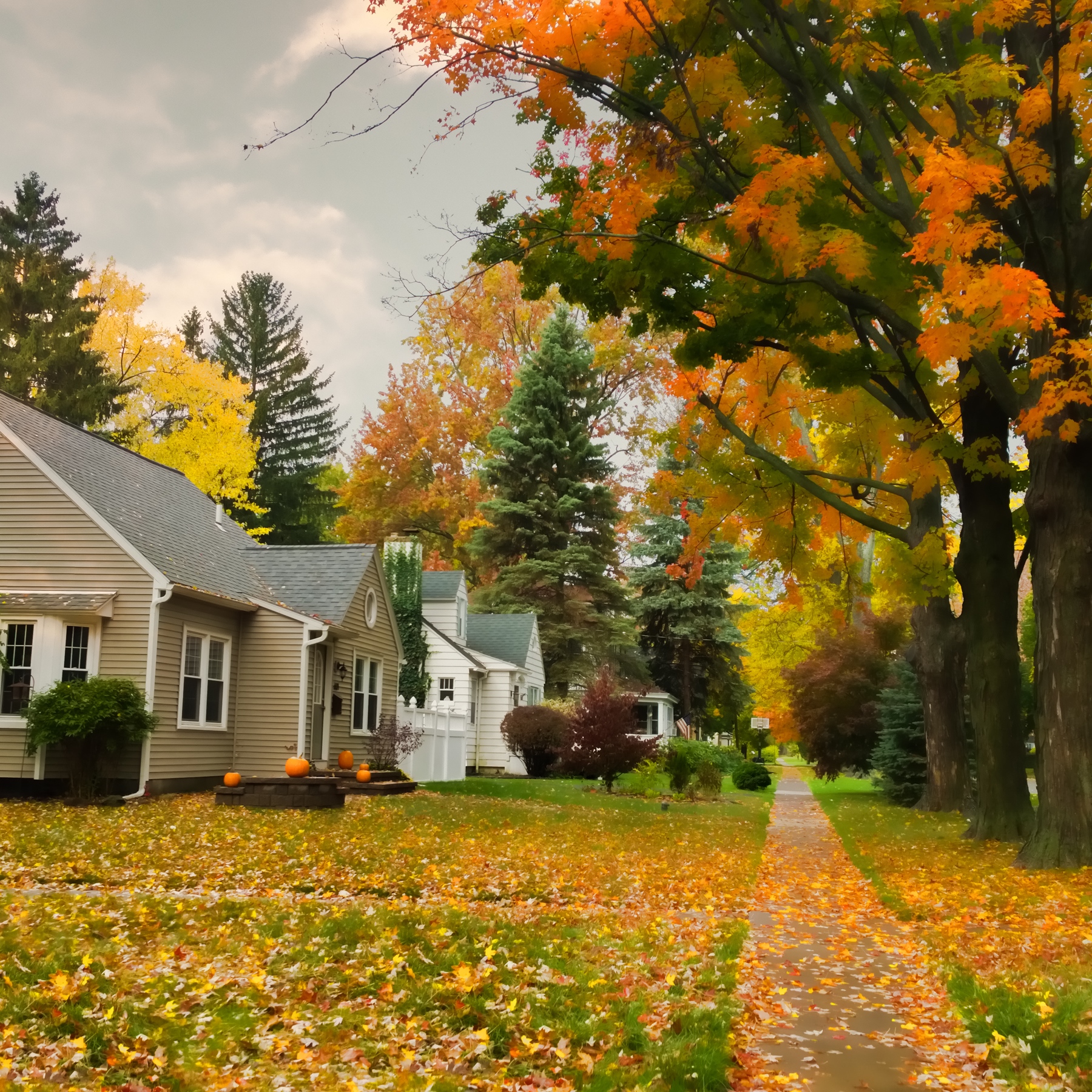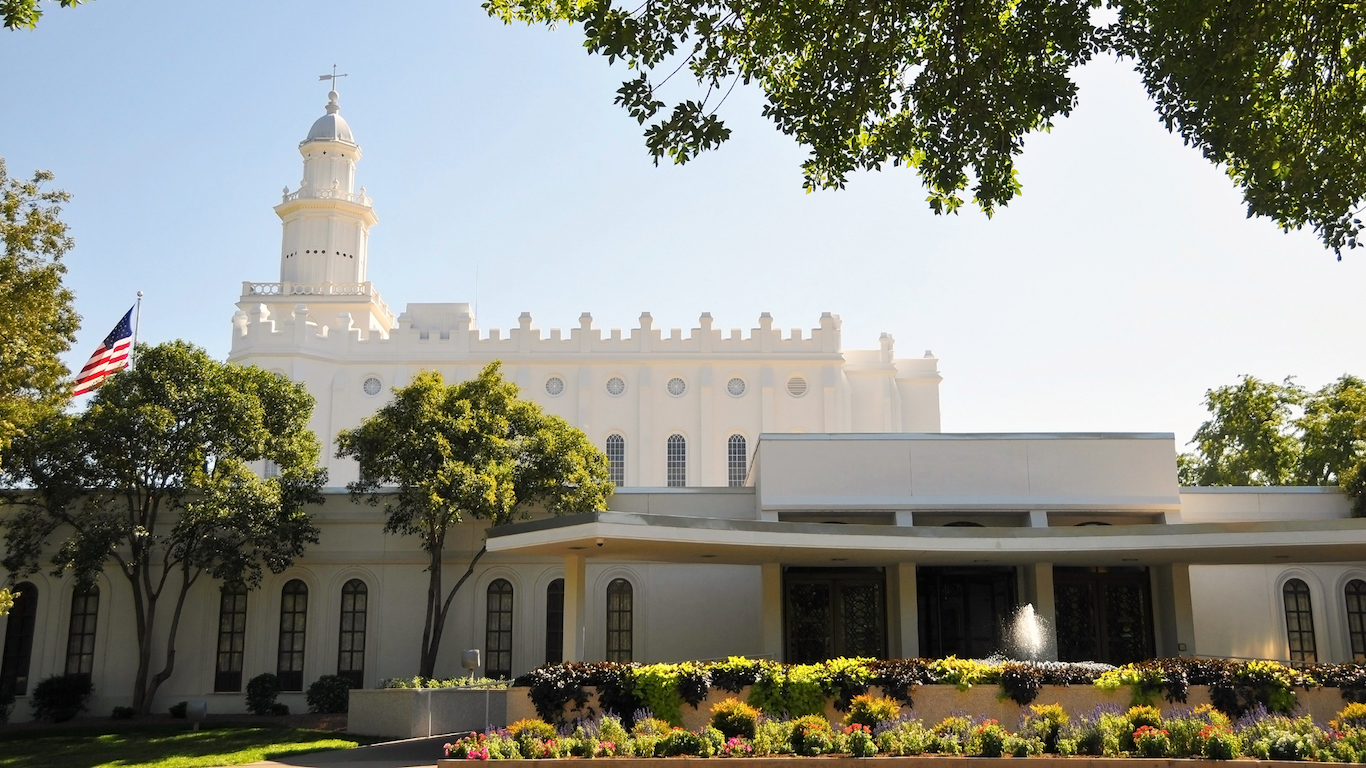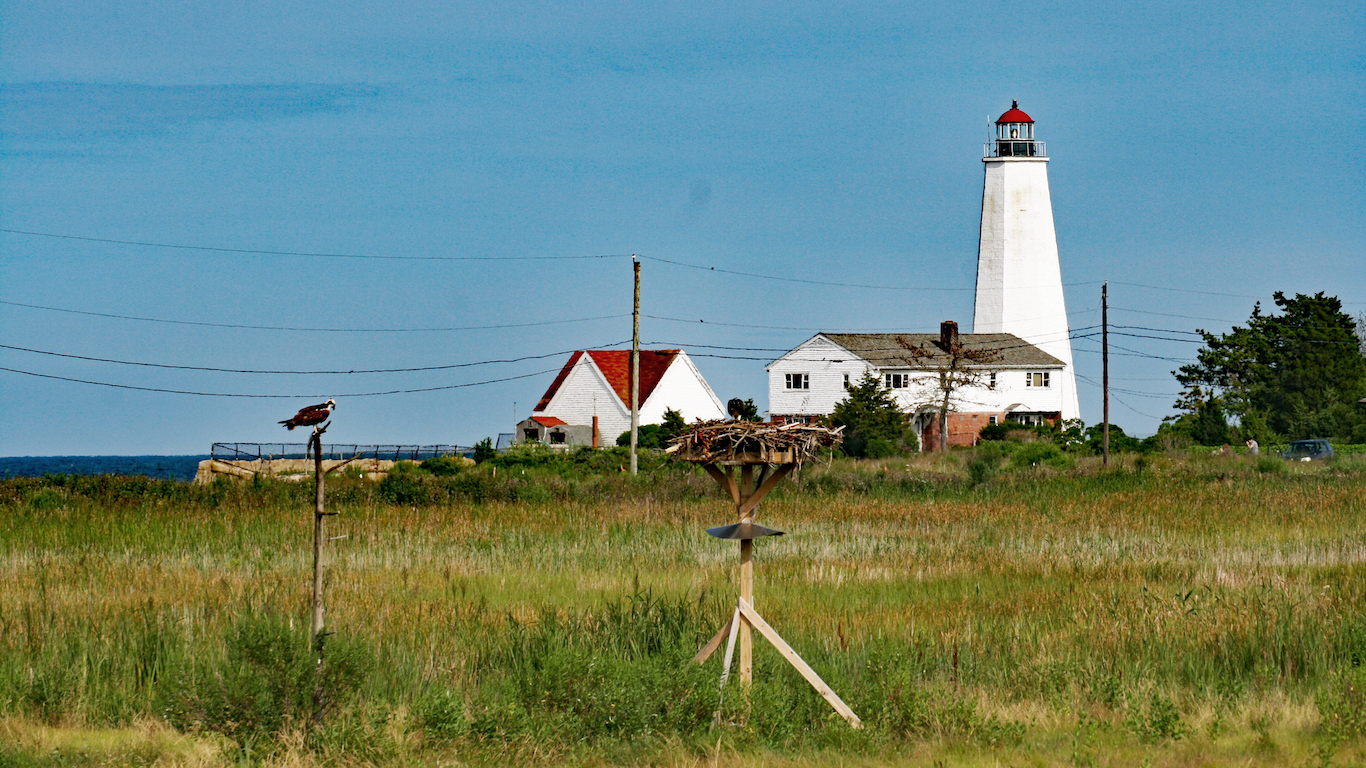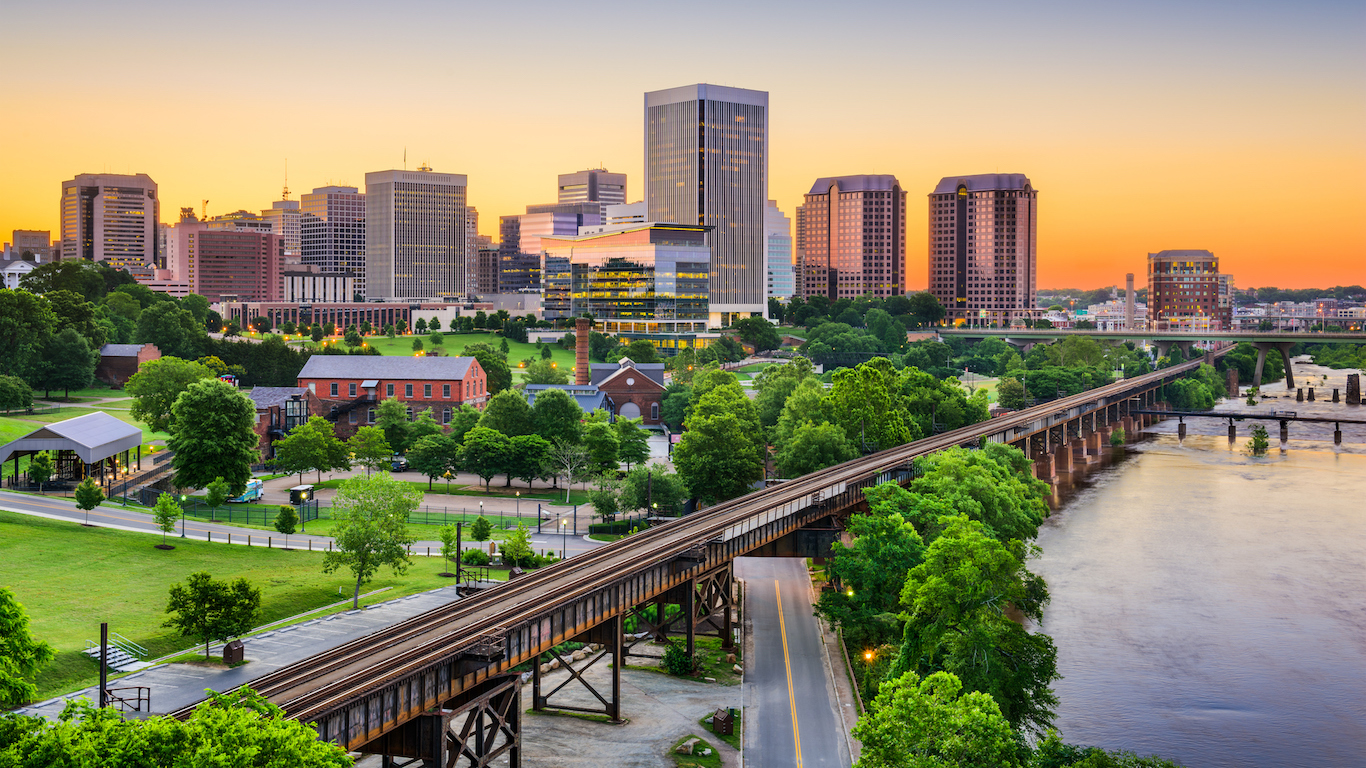
Violence in the United States has steadily declined for several decades. While the violent crime rate has fallen considerably — from 685 violent crimes reported per 100,000 Americans in 1995 to the current rate of 383 incidents per 100,000 — the national violent crime rate rose 3.0% last year.
24/7 Wall St. reviewed violent crime rates in each state from data collected through the FBI’s 2015 Uniform Crime Report Program. Violent crime includes all offenses involving force or threat of force and are broken into four categories: murder and nonnegligent manslaughter, rape, robbery, and aggravated assault. These crimes are more common in some states than in others.
Vermont is the safest state in the country with a violent crime rate of 118 incidents per 100,000 state residents.
Click here to see the 10 safest states.
Click here to see the 10 most dangerous states.
In an interview with 24/7 Wall St., Nancy G. La Vigne, director of the Justice Policy Center at public policy research organization Urban Institute, said, “crime clusters not just within major metropolitan areas but even within cities.” For this reason, La Vigne noted, it is very difficult to draw conclusions from statewide trends alone.
Violent crime is considerably more common in urban centers than in rural regions. While it is not always the case, violent crime rates across the 10 states on this list can be largely attributed to either low levels of violence reported in the states’ cities or to the absence of major cities in these states. Of the dozens of cities tracked by the FBI in the nation’s 10 safest states, only a handful report crime rates higher than the national rate. Cities such as Provo and West Jordan, Utah; Stamford, Connecticut; Boise City, Idaho; Lexington, Kentucky; and Fargo, North Dakota all report below average violent crime rates.
On the other hand, some states on this list remained among the nation’s safest despite containing cities with staggeringly high violent crime rates. Manchester, New Hampshire; Bridgeport and Hartford Connecticut, as well as Salt Lake City, Utah, for example, all have violent crime rates well over 600 incidents per 100,000 people.
Economic prosperity and the presence of job opportunities in communities can lower the likelihood of crime at the local level, and the states with the lowest violent crime rates tend to also have better economic and social conditions than more violent states. The poverty rate is lower than the national rate of 14.7% in eight of the 10 states with the lowest violent crime rates. The annual unemployment rate is lower than the national 2015 rate of 5.3% in eight of these 10 states.
Explaining these economic factors as just some of the many drivers of crime, La Vigne said, “People who engage in criminal behavior often may do so because of an absence of opportunity.”
The violent crime rate, while relatively low, decreased in only three of nation’s safest states. The violent crime rate in four of the 10 states increased slower than the nationwide uptick of 3.0% between 2014 and 2015. In the remaining three states — Vermont, Wyoming, and Utah — violent crime rates actually increased considerably faster than across the nation.
To identify the 10 safest states, 24/7 Wall St. reviewed the number of violent crimes reported per 100,000 people (the violent crime rate) in each state from the FBI’s 2015 Uniform Crime Report. The total number and rates of murder, nonnegligent manslaughter, rape, robbery, and aggravated assault, which are included in the violent crime rate, as well as burglaries, larceny, motor vehicle theft, and arson — all classified as property crime — also came from the FBI’s report. We considered these data for each year from 2011 through 2015. Annual unemployment rates for 2015 came from the Bureau of Labor Statistics (BLS). Median household income, poverty rates, the percentage of adults with at least a bachelor’s degree, population, and the percentage of adults with at least a high school diploma came from the U.S. Census Bureau’s 2015 American Community Survey.
These are the safest states in America.

10. North Dakota
> Violent crimes per 100,000: 239.4
> Total population: 756,928
> Total 2015 murders: 21.0 (5th lowest)
> Poverty rate: 11.0% (9th lowest)
While nationwide the violent crime rate rose by 3% in 2015, in North Dakota it declined by a near nation-leading 11.5%. Today, the state is 10th safest in the country. There were 239 violent crimes reported for every 100,000 state residents last year, much lower than the nationwide rate of 383 violent crimes per 100,000 Americans.
[in-text-ad]
The economic benefits from North Dakota’s oil boom seem to have contributed to less violence in the state — but not in all areas. In some parts, violent crime levels have actually risen. For example, crimes such as drug trafficking, homicides, and prostitution have spiked in the Fort Berthold Indian Reservation in northwestern North Dakota. And although the oil boom has been waning, North Dakota’s annual unemployment rate of 2.7% remains the lowest in the nation.

9. Utah
> Violent crimes per 100,000: 236.0
> Total population: 2,995,919
> Total 2015 murders: 54.0 (11th lowest)
> Poverty rate: 11.3% (12th lowest)
Violent crime increased in Utah in 2015. Driven by a spike in the aggravated assault rate, which increased by 12.4%, the violent crime rate in the state rose by 7.5% last year — more than double the nationwide increase in the violent crime rate of 3.0%. Unlike most states with low violent crime levels, property crime is relatively common in Utah. At nearly 3,000 incidents per 100,000 people, Utah’s property crime rate is ninth highest of all states. By contrast, the national property crime rate is less than 2,500 per 100,000 people. Still, violence is not especially common in Utah and the state is one of the safest in the country. With above average incomes and one of the nation’s lowest annual unemployment rates, economic prosperity could partially explain why violent crime levels remain relatively low.
As is the case in every state, violence in Utah is by no means evenly distributed. While West Jordan and Provo report violent crime rates well below the national average, Salt Lake City — the state’s largest — reports 855 violent crimes per 100,000 people, one of the higher rates of all cities tracked by the FBI.

8. Wyoming
> Violent crimes per 100,000: 222.1
> Total population: 586,107
> Total 2015 murders: 16.0 (3rd lowest)
> Poverty rate: 11.1% (10th lowest)
Wyoming, which has one of the lowest crime levels, is one of the few states to report a spike in crime last year. The state’s violent crime rate rose by 13.7% in 2015, the fifth largest jump of all states and several times greater than the national increase of 3.0%. Specifically, the number of aggravated assaults per 100,000 Wyoming residents jumped 16.9%, third largest in the nation. Still, the state’s aggravated assault rate, at 180 incidents per 100,000 residents is considerably lower than the national rate of 238 incidents per 100,000 people. Just 10 robberies, which are included in the violent crime rate, were reported for every 100,000 Wyoming residents last year, the lowest of all states and one-tenth the national robbery rate.

7. Kentucky
> Violent crimes per 100,000: 218.7
> Total population: 4,425,092
> Total 2015 murders: 209.0 (25th highest)
> Poverty rate: 18.5% (5th highest)
The relationship between income and violent crime is complex, and the connection is not a direct one. Still, Kentucky is unusual among relatively safe states because of its high poverty rate. At 18.5%, the percentage of people living in poverty trails just four other states. Similarly, unlike other states listed here, not only is the typical household income in Kentucky of $45,215 a year lower than the national median, but it is also among the lowest of all states.
[in-text-ad]
Kentucky’s murder and nonnegligent manslaughter rate, at 4.7 per 100,000 people, is in line with the national murder rate. The incidence of aggravated assault in Kentucky — aggravated assaults tend to make up the vast majority of violent crimes — is nearly the lowest of any state. Just 106 such incidents were reported for every 100,000 Kentuckians, the third lowest rate and less than half the national rate.

6. Connecticut
> Violent crimes per 100,000: 218.5
> Total population: 3,590,886
> Total 2015 murders: 117.0 (19th lowest)
> Poverty rate: 10.5% (6th lowest)
Connecticut is one of the many states and communities where financial prosperity has likely contributed somewhat to the relatively low violent crime levels. Just 10.5% of people live in poverty, the sixth lowest rate, and the typical household in Connecticut earns $71,346 annually, the fifth highest of all states.
Connecticut’s violent crime rate has historically been among the lowest. It also dropped by 8.4% in 2015, even as the national violent crime rate increased by 3.0%. The rate of aggravated assaults, the most common sort of violent crime, dropped by 10.0%, nearly the largest drop and also in stark contrast to the national increase of 3.7%.

5. Idaho
> Violent crimes per 100,000: 215.6
> Total population: 1,654,930
> Total 2015 murders: 32.0 (9th lowest)
> Poverty rate: 15.1% (20th highest)
High income areas generally have lower violent crime rates. Idaho, though, is one of just three of the 10 safest states where the median household income is below the national annual median of $55,775. Also, the state’s poverty rate exceeds the national rate of 14.7%.
Because violence tends to be more common in urban centers, most cities report violent crime rates higher than the national rate of 383 per 100,000. This is also why violence in urban areas is generally the driver of a state’s overall violent crime rate. This is no different in Idaho, where violent crimes reported in Boise — the state’s largest city — account for a large share of crime across the state. At 309 incidents per 100,000 city residents, however, Boise’s violent crime rate is well below the national violent crime rate.

4. New Hampshire
> Violent crimes per 100,000: 199.3
> Total population: 1,330,608
> Total 2015 murders: 14.0 (2nd lowest)
> Poverty rate: 8.2% (the lowest)
New Hampshire is one of just four states where fewer than 200 violent crimes were reported per 100,000 state residents in 2015. The low level of violence in the state is likely at least partially due to economic prosperity. The state’s poverty rate of 8.2% is the lowest in the nation. For a variety of reasons, cities tend to report more violence. Manchester reported 671 violent crimes per 100,000 city residents, one of the highest violent crime rates of any U.S. city. However, Manchester is also one of New Hampshire’s only major cities, and the low number of urban areas in the state could partially account for New Hampshire’s low violent crime rate.

3. Virginia
> Violent crimes per 100,000: 195.6
> Total population: 8,382,993
> Total 2015 murders: 383.0 (16th highest)
> Poverty rate: 11.2% (11th lowest)
As the largest state by population on this list, the total number of murders reported in Virginia of 383 is one of the highest of any state. Adjusted for population, Virginia’s murder and nonnegligent manslaughter rate of 4.6 per 100,000 people is just under the national rate of 4.9 murders per 100,000 people. The state’s violent crime rate, which includes murder, declined by 1.4% last year and remains one of the nation’s lowest. Meanwhile, the nation’s violent crime rate rose by 3.0% in 2015.
[in-text-ad]
While Norfolk, Richmond, and Newport News each reported above average rates of violence, Chesapeake, Hampton, Alexandria, and Virginia Beach each reported violent crime rates lower than the national average.

2. Maine
> Violent crimes per 100,000: 130.1
> Total population: 1,329,328
> Total 2015 murders: 23.0 (6th lowest)
> Poverty rate: 13.4% (22nd lowest)
Aggravated assaults, which make up the vast majority of violent crimes reported across the nation, are very rare in Maine — one of the nation’s most rural states. Despite increasing by 3.7%, fewer than 70 such incidents were reported for every 100,000 Maine residents, the lowest rate of any state and in stark contrast to the national aggravated assault rate of 238 incidents per 100,000 Americans.
On the whole, Mainers are not poor, but they are also not especially wealthy. The typical household in the state earns $51,494 a year versus the national median of $55,775 a year.

1. Vermont
> Violent crimes per 100,000: 118.0
> Total population: 626,042
> Total 2015 murders: 10.0 (the lowest)
> Poverty rate: 10.2% (4th lowest)
Vermont is the safest state in the nation, reporting just 118 violent crimes per 100,000 state residents. Due to the state’s low population of just 626,042, the total number of murders, at 10, and the total number of violent crimes, at 739, are each also the lowest of any state in the country. However, violence rose substantially in Vermont last year. The state’s violent crime rate rose by 15.1%, third most compared with other states. While the robbery rate, which is included in the violent crime rate, remains nearly the lowest in the country, it rose by a staggering 40.4% last year.
Take This Retirement Quiz To Get Matched With An Advisor Now (Sponsored)
Are you ready for retirement? Planning for retirement can be overwhelming, that’s why it could be a good idea to speak to a fiduciary financial advisor about your goals today.
Start by taking this retirement quiz right here from SmartAsset that will match you with up to 3 financial advisors that serve your area and beyond in 5 minutes. Smart Asset is now matching over 50,000 people a month.
Click here now to get started.
Thank you for reading! Have some feedback for us?
Contact the 24/7 Wall St. editorial team.


